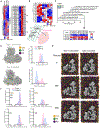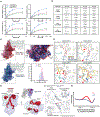Structural basis of respiratory complex adaptation to cold temperatures
- PMID: 39395414
- PMCID: PMC11601890
- DOI: 10.1016/j.cell.2024.09.029
Structural basis of respiratory complex adaptation to cold temperatures
Abstract
In response to cold, mammals activate brown fat for respiratory-dependent thermogenesis reliant on the electron transport chain. Yet, the structural basis of respiratory complex adaptation upon cold exposure remains elusive. Herein, we combined thermoregulatory physiology and cryoelectron microscopy (cryo-EM) to study endogenous respiratory supercomplexes from mice exposed to different temperatures. A cold-induced conformation of CI:III2 (termed type 2) supercomplex was identified with a ∼25° rotation of CIII2 around its inter-dimer axis, shortening inter-complex Q exchange space, and exhibiting catalytic states that favor electron transfer. Large-scale supercomplex simulations in mitochondrial membranes reveal how lipid-protein arrangements stabilize type 2 complexes to enhance catalytic activity. Together, our cryo-EM studies, multiscale simulations, and biochemical analyses unveil the thermoregulatory mechanisms and dynamics of increased respiratory capacity in brown fat at the structural and energetic level.
Keywords: CIII(2) rotation; brown adipose tissue; cellular adaptation; electron transport chain; membrane lipid remodeling; respiratory complexes.
Copyright © 2024 Elsevier Inc. All rights reserved.
Conflict of interest statement
Declaration of interests The authors declare no competing interests.
Figures






Update of
-
Structural basis of respiratory complexes adaptation to cold temperatures.bioRxiv [Preprint]. 2024 Jan 17:2024.01.16.575914. doi: 10.1101/2024.01.16.575914. bioRxiv. 2024. Update in: Cell. 2024 Nov 14;187(23):6584-6598.e17. doi: 10.1016/j.cell.2024.09.029. PMID: 38293190 Free PMC article. Updated. Preprint.
References
-
- Kazak L, Chouchani ET, Jedrychowski MP, Erickson BK, Shinoda K, Cohen P, Vetrivelan R, Lu GZ, Laznik-Bogoslavski D, Hasenfuss SC, et al. (2015). A Creatine-Driven Substrate Cycle Enhances Energy Expenditure and Thermogenesis in Beige Fat. Cell 163, 643–655. 10.1016/j.cell.2015.09.035. - DOI - PMC - PubMed
-
- Latorre-Muro P, O’Malley KE, Bennett CF, Perry EA, Balsa E, Tavares CDJ, Jedrychowski M, Gygi SP, and Puigserver P (2021). A cold-stress-inducible PERK/OGT axis controls TOM70-assisted mitochondrial protein import and cristae formation. Cell Metab 33, 598–614.e7. 10.1016/j.cmet.2021.01.013. - DOI - PMC - PubMed
MeSH terms
Grants and funding
LinkOut - more resources
Full Text Sources
Molecular Biology Databases

